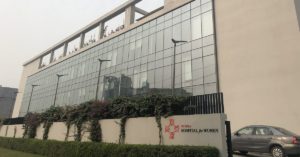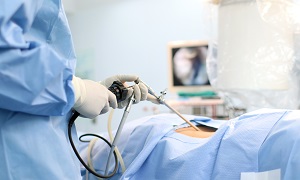Best Doctors in India for Adrenalectomy
Best Hospitals in India for Adrenalectomy
Wockhardt Hospitals, Mumbai
- City: Mumbai, India
Hospital Highlights:
- Wockhardt Hospitals were established in the year 1973, originally called First Hospitals and Heart Institute.
- Wockhardt Hospitals are super specialty health care networks in India, nurtured by Wockhardt Ltd, India’s 5th largest Pharmaceutical and Healthcare company.
- Wockhardt Hospitals is associated with Partners Harvard Medical International, an international arm of Harvard Medical School, USA.
- Wockhardt Heart Hospital performed India’s first endoscopic heart surgery.
- The hospital has a state-of-the-art infrastructure equipped with the latest technologies and modern equipment.
- It has special Centers of Excellence dedicated to the major specialties to provide hassle-free and high-quality clinical care.
Pushpawati Singhania Hospital & Research Institute, New Delhi
- City: New Delhi, India
Hospital Highlights:
- Established in 1996, Pushpawati Singhania Research Institute is one of the top hospitals in the NCR region, as well as one of the top facilities in India for gastroenterology. The hospital is one of South Asia’s first institutes in medical and surgical treatment for diseases related to digestion.
- The hospital is equipped with state-of-the art facilities coupled with the latest equipment as well as renowned consultants from various parts of India as well as other parts of the world.
W Pratiksha Hospital, Gurgaon
- City: Gurugram, India
Hospital Highlights:
- W Pratiksha Hospital, Gurugram, is one of the best hospitals in the NCR region. It is also a top hospital in India for IVF. Since its inception, the hospital has performed over 5500 successful IVFs. The hospital also specializes in gynecology.
- With over 20 years of experience in providing quality healthcare, the hospital is known as one of the most trusted and valued health providers in India.
- Equipped with world-class medical facilities and advanced technology, the hospital’s doctors and clinicians also have a track record of delivering excellent results. The hospital is also known for focusing on preventive well-being as much as on curative treatment.
- The hospital has earned the trust of its patients, by providing the best available treatments at affordable costs.
Narayana Superspeciality Hospital, Gurugram
- City: Gurugram, India
Hospital Highlights:
- Situated near DLF Cyber City, Gurugram, Narayana Superspecialty Hospital is one of the top medical facilities in the Delhi NCR region, catering to the needs of the people. Known for its commitment to quality medical care and patient service, the hospital is a state-of-the-art facility with planned and well-equipped sections, which includes a spacious OPD area as well as comfortable patient rooms.
- It is the closest super-specialty hospital from Indira Gandhi International Airport towards Gurugram, and also the nearest super specialty hospital from DLF Cyber City. It is also close to major residential areas in Gurugram.
- It is part of the renowned Narayana Health Group. Established in 2000, by Dr. Devi Shetty, a renowned cardiac surgeon, it has grown to be one fo India’s leading healthcare groups.
Sir Ganga Ram Hospital, New Delhi
- City: New Delhi, India
Hospital Highlights:
- Sir Ganga Ram Hospital, New Delhi is known to provide the latest medical procedures with the latest technology in all of its units.
- The hospital has a team of reputed doctors, nurses, and healthcare professionals that ensure that patients receive quality care at affordable costs.
- Staffed with a team of highly qualified doctors, dedicated nurses, and paramedical and non-medical staff, the hospital aims to lead in healthcare delivery, medical education, training, and research.
- As per the vision of the founder, the hospital also provides free treatment to the economically weaker sections of society.
- Sir Ganga Ram Hospital also provides training to young doctors under the Diplomate in National Board(DNB) program. The DNB program at the hospital was started in 1984 and it is known for currently running the maximum number of DNB specialties in the country. It also has the distinction of having the first bone bank in India.
CK Birla Hospital, Gurugram
- City: Gurugram, India
Hospital Highlights:
- The CK Birla Hospital in Gurugram is a NABH-accredited multi-specialty hospital.
- The hospital strives to increase the quality of healthcare by focusing on UK NHS nurse and midwife training requirements. Policies and practices derived from the National Institute for Health and Treatment Excellence (NICE) recommendations in the United Kingdom ensuring that a strong focus on safety, high-quality clinical care, and sanitation is maintained.
- The hospital’s cutting-edge technology and facilities allow for real-time communication and seamless collaboration among caregivers, ensuring accuracy and the best possible results. Those with foreign experience and accreditations make up part of the hospital’s team of clinicians.
KIMS Hospital, Hyderabad
- City: Hyderabad, India
Hospital Highlights:
- KIMS Hospital (a brand name of Krishna Institute of Medical Sciences) is one of the largest and best multi-speciality hospitals in Hyderabad. The hospital provides various treatments to an enormous number of patients.
- The hospital has a capacity of more than 3000 beds. KIMS Hospitals offers different healthcare services in more than 25 specialities and super specialities.
- The hospital is equipped with modern medical equipment and technology. It has robotic equipment to provide minimal invasive techniques for patients.
- The hospital is aimed at providing world-class healthcare facilities and services at an affordable cost for patients.
- The various specialities and departments of the hospital include neurosciences, gastroenterology & hepatology, robotic science, reproductive sciences, dental science, oncological sciences, organ transplantation, heart and lung transplantation and mother and child care.
Fortis Hospital, Shalimar Bagh
- City: New Delhi, India
Hospital Highlights:
- Fortis Hospital in Shalimar Bagh is a multi-super specialty hospital that strives to provide world-class patient care by leaving no stone unturned.
- Fortis, Shalimar Bagh, with 262 beds and a 7.34-acre footprint, provides the best level of medical care through its team of doctors, nurses, technicians, and management professionals.
Reliance Hospital, Mumbai
- City: Mumbai, India
Hospital Highlights:
- Reliance Hospital is one of the best super-specialty care hospitals in Navi Mumbai.
- The main purpose of this hospital is to become a trustworthy place for the best health and hope for society. The hospital is well connected to the suburbs of Mumbai and Navi Mumbai.
- The hospital has various specialty departments, viz., Accident & Emergency, Anesthesiology, Dental Services, Dermatology, Diabetology, Dietetics Nutrition, Endocrinology, ENT, Gastroenterology, General Surgery, Gynaecology And Obstetrics, Hepato Pancreato Biliary Surgery, Infectious Disease, Internal Medicine, Interventional Radiology, Laboratory Medicine, Minimal Access Laparoscopic Surgery, Nephrology, Neurosciences, Opthalmology, Orthopaedics, Paediatrics, Pain Management Palliative Care, Physical Medicine Rehabilitation, Plastic And Reconstructive Surgery, Psychiatry, Pulmonary Medicine, Radiology, Rheumatology, Transplant, Urology Andrology, Vascular Surgery
Lilavati Hospital & Research Centre, Mumbai
- City: Mumbai, India
Hospital Highlights:
- Lilavati Hospital & Research Centre is India’s premier multi-speciality tertiary care hospital and has been recognised as a global medical excellence centre.
- Lilavati Hospital & Research Centre has built an unrivalled level of trust with its patients over the years, thanks to a solid foundation that comprises cutting-edge facilities, the best medical competence, research, education, and charity endeavours.
- The hospital is quite proud of the fact that it now serves patients from all kinds of backgrounds, not just from the United States but from all around the world.
- The hospital has a total of 323 beds, one of the largest Intensive Care Units (ICUs), 12 Operation Theatres with modern amenities, over 300 consultants, and almost 1,800 personnel.
ADRENALECTOMY
Your adrenal glands are two small organs, which are located above each kidney. They are triangular in shape and around the size of your thumb. These glands are also known as endocrine glands since they produce hormones.
Surgery to remove an adrenal gland is known as Adrenalectomy. It might be sometimes necessary to remove an adrenal gland if a tumor is producing excess hormones or is quite large in size, i.e. more than 2 inches or 4 to 5 centimeters. Surgery might also be required if the tumor is malignant or suspected to be cancerous. Sometimes both glands might require removal. In such cases, you will need to take supplemental hormone medications.
However, if only one of them is removed, the other one will take over full function without the need for any ongoing medications.
Purpose
The most common reason why people can choose to go for adrenalectomy is because of increased production of hormones by the adrenal glands. Generally, this is caused by an adrenal mass or tumor. The most common form of tumor is pheochromocytoma and this can lead to various problems, which can include blood pressure.
Preparation
Before the surgery is scheduled, you might need to provide your doctor with your medical records, radiology images, lab test results, etc.
If you are considered a suitable candidate for the surgery, you will need to be on a liquid diet for 24 hours before the surgery. This can include broth, tea, fruit juice, coffee and soda. However, you should avoid soups, orange or tomato juice, milk, milkshakes, cream, cream soups or oatmeal. You might also be prescribed medications for your blood pressure. It is very important to take them as directed.
If you take aspirin or any anti-inflammatory agents, you might need to stop them at least a week before your surgery. Don’t eat or drink anything after midnight on the night prior to your surgery.
Procedure
The surgery is generally performed using the laparoscopic method and general anesthesia is used so that you won’t feel any pain.
First, a cannula, a narrow instrument resembling a tube is placed into the abdominal cavity in the upper abdomen or flank just below the ribs. Your surgeon will next insert a laparoscope, which is connected to a special camera. It will be inserted through the cannula. This will give your surgeon a proper magnified view of the patient’s internal organs on a TV screen.
Next, more cannulas are inserted and they allow your surgeon to separate the adrenal gland from its attachments. Once it has been dissected free, it is placed in a tiny bag and removed through an incision. It is usually necessary to remove the entire adrenal gland to safely remove the tumor.
After the adrenal gland is removed by your surgeon, the small incisions are closed.
In some cases, the doctor might not be able to perform the surgery using the laparoscopic method. In such cases, the open procedure is preferred.
Some factors that can increase the possibility of having to convert to an open procedure include:
- Obesity
- A history of prior abdominal surgery leading to dense scar tissue
- Tumor showing characteristics such as large size or invasion into any adjacent structures
- Inability to clearly visualize the adrenal gland
The decision to perform an open surgery can be made by your surgeon either before or during the procedure.
Recovery
You will need to stay in the recovery room for some hours. The team will monitor you closely as you wake up from the anesthesia. Your doctor will most likely recommend a liquid diet for dinner. The next morning, however, you will be likely to offer regular food.
If you experience too much pain, you need to inform the healthcare team and you will receive medications. You might experience a sore throat as well. This is due to the placement of anesthesia tubes during surgery. Throat lozenges and sprays should help. Patients who undergo laparoscopic adrenalectomy can generally go home after staying at the hospital for a single night. Patients who undergo the open method might require staying at the hospital for up to five nights.
Risks
Like any surgery, there are few risks of complications. Some of the complications that can occur include:
- Adverse reaction to general anesthesia
- Bleeding
- High blood pressure
- Injury to other organs
- Wound problems, heart attacks, blood clots and other serious complications can occur, although they are uncommon
Remember to contact your surgeon if you see any signs of infection, or your pain is not controlled by your pain medications.
Some of the signs of infections are:
- Temperature greater than 100 degrees F for over 24 hours
- Swelling, redness, tenderness or any unusual drainage from your incisions
- Nausea, vomiting or shaking chills












